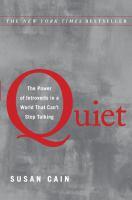
We have all taken personality tests that put us into one box or another in an attempt to better understand ourselves. In Susan Cain’s book Quiet: The Power of Introverts in a World that Can’t Stop Talking, Cain analyzes the introvert/extrovert dichotomy with a particular focus on how introverts think and what motivates them. Cain argues that we live in an extrovert-centric society that values and praises the high achieving socialites over the less outgoing thinkers. Cain speaks up for and defends those whose voices have gone unheard for far too long.
Quiet reads like a text book, analyzing what makes an introvert tick or, quiet often, what makes them stop ticking. My main take aways from Quiet are the workplace focused sections. One topic Cain analyzes is the open office floor model, in which workspace is communal rather than sectioned off in the 90’s style cubical plan. Cain argues against this design, illuminating how overwhelming and stifling it can be for introverts to have nowhere to retreat to deeply think and recharge. Cain also gives useful pointers for how to communicate with introverted coworkers and how to understand their thought processes. Cain does an excellent job of raising awareness of the many different ways people learn and create, always with her focus on the underrepresented introvert.
This book inspired a lot of self-reflection and evoked thoughtful questions about those with whom I interact, both in my professional and personal life. However, when I later went back and thought about the deep insight that it seemed to impart while I was reading it, my “enlightened” notes were far less inspiring. In retrospect, I would classify this as an intellectual comfort read. It is satisfying and vindicating to read about others with whom you share qualities and to know that these qualities are normal and acceptable. But upon further reflection, I don’t feel like I actually learned that much, despite its academic narrative.
My biggest issue with the book is the way Cain endlessly describes introverts in nothing but sunshine-y ways. Even the most extroverted person would walk away from reading this thinking “am I an introvert too?” Of course we all want to claim to be the thoughtful, creative, reflective, intuitive people that Cain identifies as introverts. Of course we’ve all felt exhausted after a party or presentation and wanted nothing but to hibernate by ourselves and recharge. And of course we’ve all felt shy or intimidated at one time or another, but to what extent does that make us an introvert vs. an extrovert? In the end, it is all a spectrum and we all possess aspects of both personalities. Cain does mention this concept at various times but I don’t think it was reinforced enough. This is not an “us” and “them” issue, but more of an a la cart menu where we each uniquely put into effect traits that work for us. What this book successfully does though is remind us of all the benefits of our introverted side and makes us more proud of them.
For those who found inspiration and solace in this book, try picking up Happier at Home by Gretchen Rubin. In this sequel to the popular 2009 book The Happiness Project, Rubin divides a year into eleven home-centered topics (such as possessions, how time is spent, and parenting), then she spends a month breaking each down and assessing in an attempt to improve levels of happiness. Like Quiet, it is a self-actualizing book that helps one look at and analyze day to day life.
